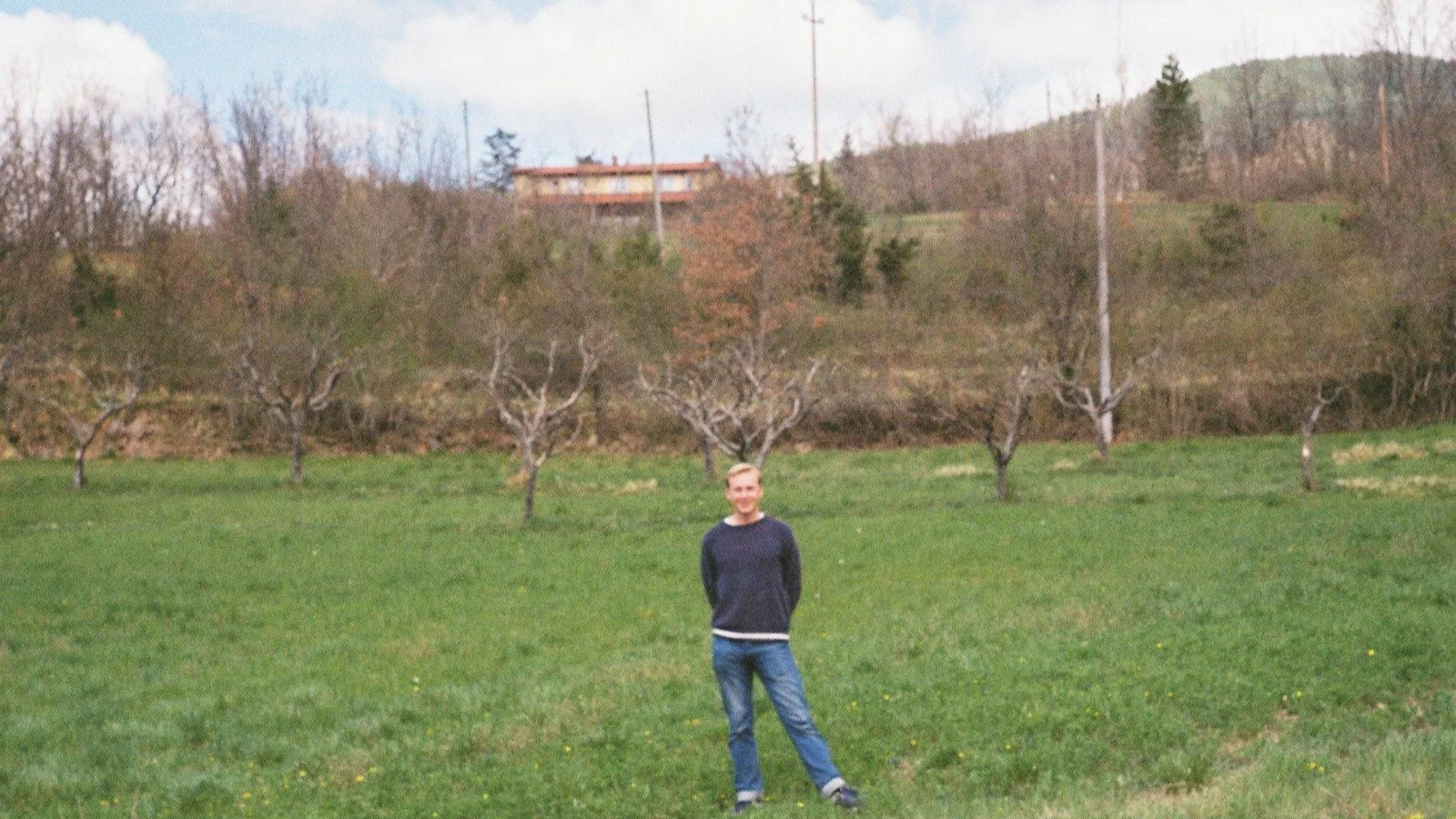Why Mountains?
Prasad in Italy, 2021
I grew up in the foothills of the Himalayas, though the meaning of that place only became clear to me after I left. We meditated morning and evening, and the rest of life was ordinary childhood — playing football, climbing trees, laughing, getting into trouble, fighting, making up. Through all of it, the mountains were simply there: steady, familiar, almost like a quiet witness in the background.
When I moved back to the UK at sixteen, I felt a kind of isolation, the sense that I didn’t quite understand the culture I’d returned to, or how I was meant to fit into it. That feeling pushed me inward. It made me reflect on myself, and who I was in all of this.
Over time, I realised that the silence I rediscovered in myself was the same silence I’d felt in the presence of the mountains. That awareness has stayed with me, and it’s why mountains continue to appear in my paintings — not just as landscapes, but as reminders of that inner stillness.
Why Mountains Carry Meaning Across Cultures
Sunset over Blue Mountain
I never thought of mountains as symbolic when I was young. They were just part of the environment. But the more I painted them, the more I noticed how often mountains appear in different traditions as something that points inward.
Certain themes repeat themselves:
steadiness
perspective
quiet
clarity
elevation
the sense of something unchanged
A mountain rises, but it doesn’t move. It provides scale. It places things in context. It quietly suggests a way of seeing that isn’t caught up in the immediate.
Mountains in Classical Chinese Landscape Thought
Sesshu Toyo (left) & Huang Gongwang (right)
In classical Chinese culture, mountains were associated with perspective and reflection. Scholar-officials often kept landscape scrolls nearby. When work became mentally heavy, they would pause and look at a painting — not to escape life, but simply to take a step back and reset their minds.
A mountain painting served as a reminder of something steady and larger than whatever problem was in front of them. The practice was a way of orienting the mind.
Chinese landscape painters weren’t trying to record a place exactly as it looked. They were expressing the inner experience of being with mountains — the space, the quiet, the sense of proportion.
Mist and empty areas in paintings weren’t just atmospheric; they created openings for the viewer’s mind. The unpainted space mattered as much as the painted forms.
This is why mountains became central subjects. They offered a natural shape for ideas about steadiness, balance, and the relationship between form and emptiness.
Huang Gongwang & Sesshū — Two Approaches to Clarity
Two painters from different traditions illustrate two useful ways of understanding insight.
Huang Gongwang (China)
Huang worked slowly and patiently. His landscapes developed through observation, adjustment, and layers of wash. His approach suggested that understanding is something gradually cultivated.
Sesshū Toyo (Japan)
Sesshū sometimes worked with sudden, spontaneous strokes, especially in his “broken ink” pieces. These paintings feel immediate, as if the form appeared in a moment of clear perception.
These two approaches — gradual and sudden — appear in many traditions. They’re not contradictory; they describe different aspects of how clarity can arise.
My Process: Spontaneity First, Then Structure
Chinese Ink on Canson Arches paper
My own way of painting mountains reflects both of these approaches.
Before anything else, I begin with a spontaneous marbled ground — ink and water interacting in ways I can’t fully control. Shapes emerge on their own. This part always feels fresh, almost like the first hint of an idea revealing itself.
After that, I work in transparent washes, gradually building the forms. This part is slow, steady, and considered. The painting takes shape through repetition and adjustment.
That combination — a spontaneous beginning followed by patient refinement — feels close to how understanding often forms in life. Something appears, and then you spend time working with it.
Nanao Sakaki — A Useful Image
There’s a poem by Nanao Sakaki that expresses something simple but accurate about mountains and the self:
Look! a mountain there.
I don't climb mountain.
Mountain climbs me.
Mountain is myself.
I climb on myself.
There is no mountain
nor myself.
Something
moves up and down
in the air.
It suggests that the boundary between the mountain outside and the mountain within isn’t always clear-cut. It’s an idea that aligns with how many Asian traditions think about nature and the mind.
A Mountain for Your Wall, A Mountain for Your Mind
Crimson Sunset Peaks
To own a mountain is not to own a view.
It is to keep a reminder of something you already know:
that stillness is available
that perspective is possible
that the mind can rise above its noise
and that something steady exists beneath change
A mountain on the wall becomes a quiet presence —
not demanding attention, but offering it back to you.
A companion in clarity.
A steadying force.
A presence that watches without moving.
This is the quality I look for when painting mountains — not dramatic scenery, but a sense of the witness behind it.
Available prints






